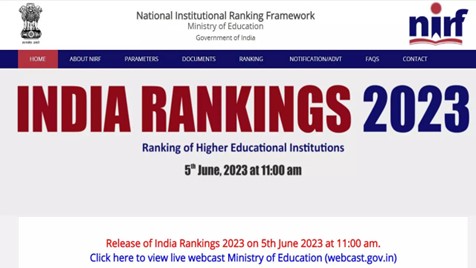- Courses
- GS Full Course 1 Year
- GS Full Course 2 Year
- GS Full Course 3 Year
- GS Full Course Till Selection
- Essay Target – 150+ Marks
- Online Program
- GS Recorded Course
- NCERT (Recorded 500+ Hours)
- Polity Recorded Course
- Geography Recorded Course
- Economy Recorded Course
- AMAC Recorded Course
- Modern India, Post Independence & World History
- Environment Recoded Course
- Governance Recoded Course
- Science & Tech. Recoded Course
- International Relations and Internal Security Recorded Course
- Disaster Management Module Course
- Ethics Recoded Course
- Current Affairs Recoded Course
- CSAT
- 5 LAYERED ARJUNA Mentorship
- Public Administration Optional
- ABOUT US
- OUR TOPPERS
- TEST SERIES
- FREE STUDY MATERIAL
- VIDEOS
- CONTACT US
Flaws in NIRF Ranking
Flaws in NIRF Ranking
21-06-2023

Latest Context
Recently, the national rankings for universities conducted by the National Institution Ranking Framework (NIRF) which was established by the Ministry of Education have been found flawed by various experts.
Ranking Procedure of NIRF and Concerns with the Ranking: It issues rankings across many categories: ‘Research Institutions’, ‘Overall’, ‘Universities’, and ‘Colleges’, and specific disciplines like engineering, management, pharmacy, law, etc. It prepares ranking by their total score by using five indicators to determine this score:
- Teaching, Learning & Resources (30% weightage)
- Research and Professional Practice (30%)
- Graduation Outcomes (20%)
- Outreach and Inclusivity (10%)
- Perception (10%)
- Concerns with NIRF Ranking: There are many concerns of academic communities regarding the process of formulating indicators and the methods used.
- Under NIRF, the evaluation process lays emphasis on research and professional practices by paying attention to bibliometric measures and avoiding other forms of intellectual contributions like monographs, book chapters, books, non-traditional outputs like popular articles, workshop reports, and other forms of grey literature.
- According to scholars and experts, bibliometric indicators do not pay the required attention to the intricacies of scientific performance, and therefore a more comprehensive evaluation methodology is needed. The main reason for choosing bibliometrics as a tool to assess research output is its efficiency and convenience in comparison to qualitative assessments performed by subject experts which are more resource-intensive and time-consuming.
Key Note: Bibliometrics means the measurable aspects of research like the number of papers published, the frequency of their citation and the impact factors of journals, etc.
Ramifications of Flawed Rankings
- It will Misguide prospective students and parents about the quality and reputation of institutions.
- It will increase unfair competition and incentives among institutions to game the system.
- It will raise question mark on the credibility and usefulness of the ranking framework.
- To neglect other aspects of institutional excellence like innovation, diversity, social impact, etc.
- It may affect negatively the reputation, perception, and competitiveness of foreign educational institutions in case they set up their campuses in India.
Measure to Improve NIRF Ranking
- By providing adequate resources, incentives, and recognition, to nurture faculty research output.
- Bibliometrics must not be used as the only criteria for any evaluative purpose. They ought to be combined with other forms of evaluation like peer review, to make informed decisions.
- To showcase and disseminate the research publications and impact creating an institutional repository could be a useful measure.
- By creating an outcome-based curriculum, using innovative pedagogies, and ensuring student feedback and satisfaction, to improve the teaching-learning process.
- By improving the placement, entrepreneurship, and higher education opportunities for students to enhance graduation outcomes.
- By increasing the diversity of students, faculty, and staff, and engaging with the local and global communities to promote outreach and inclusivity.
- NIRF Rankings must be transparent about the data to collect, the way of collection, and the manner that data becomes the basis for the total score.



